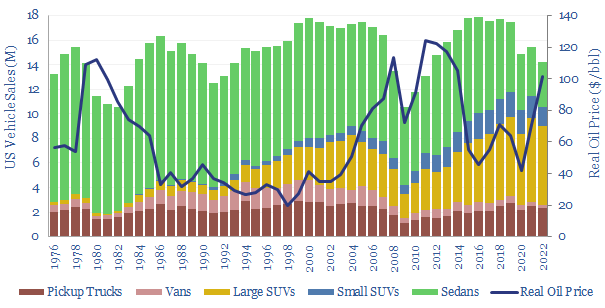This data file compares the US vehicle fleet over time. Improving fuel economy has been muted by rebound effects, such as greater mobility and larger vehicles. Oil prices clearly influence the types of vehicles being purchased, their masses and their fuel economy. Recent fuel economy improvements are particularly impressive against this backdrop.
The fuel economy of new passenger cars (i.e., sedans) in the United States has doubled over the past half century, from 15mpg in 1976 to 33mpg in 2022 (+120%, +1.8% pa, yellow line below), yet total US gasoline demand has increased from 7Mbpd in 1976 to 8.8Mbpd in 2022 (+25%, +0.5% pa, data available from the EIA). How can we disaggregate these rebound effects?
First, the US population has grown from 220M people in 1976 to 330M in 2022 (+50%, +0.9% pa). Hence on a per capita basis, gasoline demand has actually fallen by 17.5% (-0.4% pa).
Second is timing. The weighted-average combustion vehicle in the world has a current age of 12-years and an expected service life of 20-years (data here). It takes time for more efficient vehicles to displace the older and less efficient fleet, and we think this explains c14% (0.2% pa) of the 1976-2022 delta between new vehicle fuel economy and gasoline demand, as is represented by the dark blue line below.
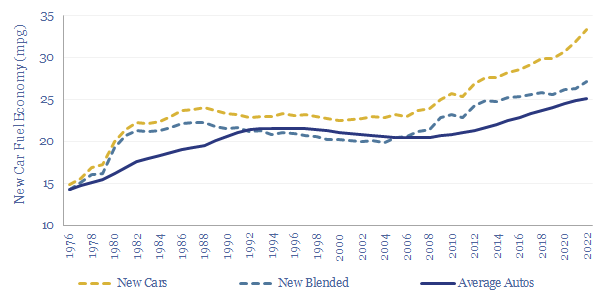
Increasing mobility. Vehicle miles driven per capita has increased by 45% from 1976 to 2022 (0.8% pa). We also think that the rise of aviation (data here) has displaced what would have been car travel in the past, as aviation accounted for c8% of a typical person’s domestic mobility in 1976, doubling to 17% in 2022 (chart below). Total mobility has increased by 50% since 1976 (+0.9% pa)
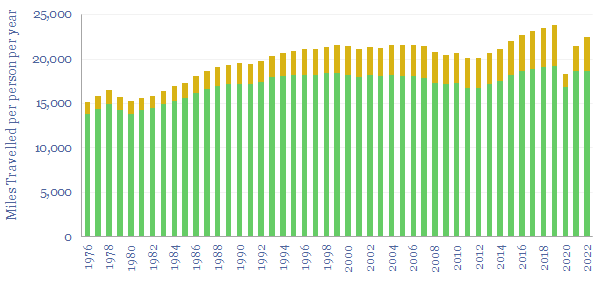
The vehicle mix has also shifted away from small and efficient sedans towards larger and less efficient SUVs and trucks. The average vehicle has grown from 1.4 tons at trough in 1982 to a new peak of 1.9 tons in 2022 (chart below). This actually makes the improvement in vehicle efficiency even more impressive. The fuel economy of a vehicle is a function of its mass and cross sectional area.
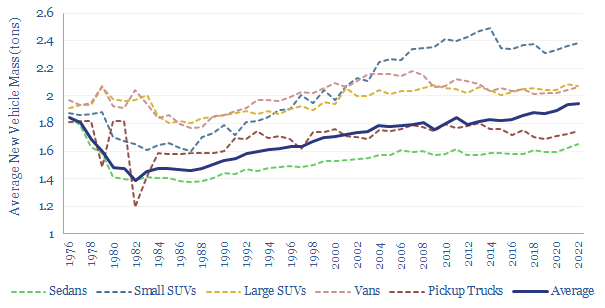
A wide gap remains between the fuel economy of different vehicle types. Sedans achieve 33mpg in 2022, while large SUVs achieve 25 mpg and pickups achieve 20 mpg (chart below). We also see a large rise in electric vehicle sales and their fuel economy versus other vehicle types is summarized here.
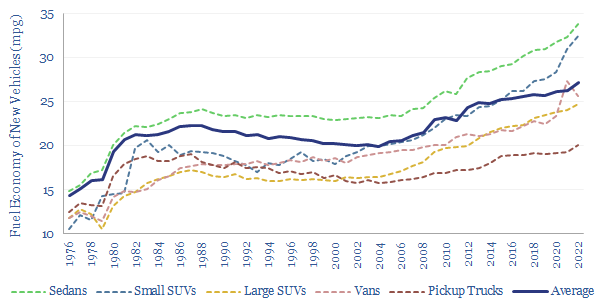
How do vehicle purchasing decisions vary with oil prices? Real oil prices below $40/bbl have seen a -0.8% annual deterioration in the fuel economy of the aggregate US vehicle purchase, due to greater shares for SUVs and trucks. Conversely, real oil prices above $80/bbl have seen a c2% annual improvement in fuel economy, as consumers preferred to purchase a greater share of more fuel-efficient sedans and other vehicles.
Please download the data-file for useful data into vehicle types over time, fuel economies and their relationship with oil prices and mobility. Some of the data are tabulated from EPA disclosures. We have also written a separate article summarizing all of our vehicle research.

